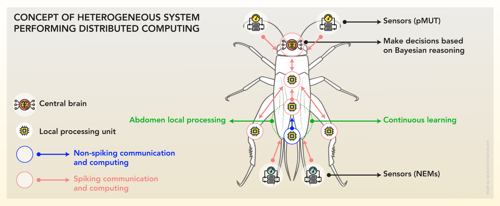The grant, worth €3mn, will be used to apply the technology to applications such as consumer robotics, implantable medical diagnostic microchips and wearable electronics.
While powerful algorithms will enable machines to learn from experience and interact autonomously with the environment this will require nanosystems with breakthrough architectures enabled by novel nanotechnologies, because current architectures are inefficient in handling AI tasks.
Moving data between processors and memories, for example, uses up to 90 percent of the devices’ total energy consumption and research groups have tried to overcome this limitation by developing in-memory computing architectures that use nanoscale memory devices for both processing and data storage. This ambitious approach, however, requires very high-density, high-resolution, non-volatile memory with unlimited endurance. This capability does not currently exist despite a decade of focused efforts to create these memories.
“My project is to take inspiration from insects’ nervous systems to relax hardware requirements in terms of memory density and reliability, and to build the new nanosystems we need to enable learning from a very limited volume of noisy data,” explained Vianello.
“Crickets make accurate decisions based on sluggish, imprecise, and unreliable neurons and synapses in order to escape their predators. Looking closely at their biology, we identified a diversity of memory-like functions at play in their sensory and nervous systems,” said Vianello. “By combining these different functions, the cricket’s internal computing system achieves amazing performance and energy efficiency.
“Our ERC-funded project will use these novel nanoscale memory technologies to mimic the biological mechanisms observed in insects and create high-performance, energy-efficient, silicon-based nanosystems.”

Vianello discovered that different functions of the insect’s nervous system closely resemble functions performed by deterministic, probabilistic, volatile and non-volatile memories that she is currently developing with fellow CEA-Leti scientists.
“Vianello’s work will open up new research perspectives towards more energy-efficient embedded intelligence capable of online learning,” said Jean-René Lequepeys, deputy director and CTO at CEA-Leti. “It is a real technological and application breakthrough that will combine the latest developments in microelectronics using new generations of non-volatile memories and drawing inspiration from the living world. This research work is fully in line with the priorities of the institute and will open up great opportunities for world premieres and commercialisation.”
Led by Vianello, a multi-disciplinary team will make networks of physical nanoscale memory devices that translate insect biological principles into physical principles to enable learning from very limited volumes of noisy data, such as data measured in real time from different sensors in video cameras, radar sensors, ECG, EMG, bio-impedance streams and potentially also brain signals through EEG sensors and neuro-probes.
“Since the ideal memory does not exist today, the project aims at building a hybrid synapse that co-integrates different memory technologies,” explained Vianello.













